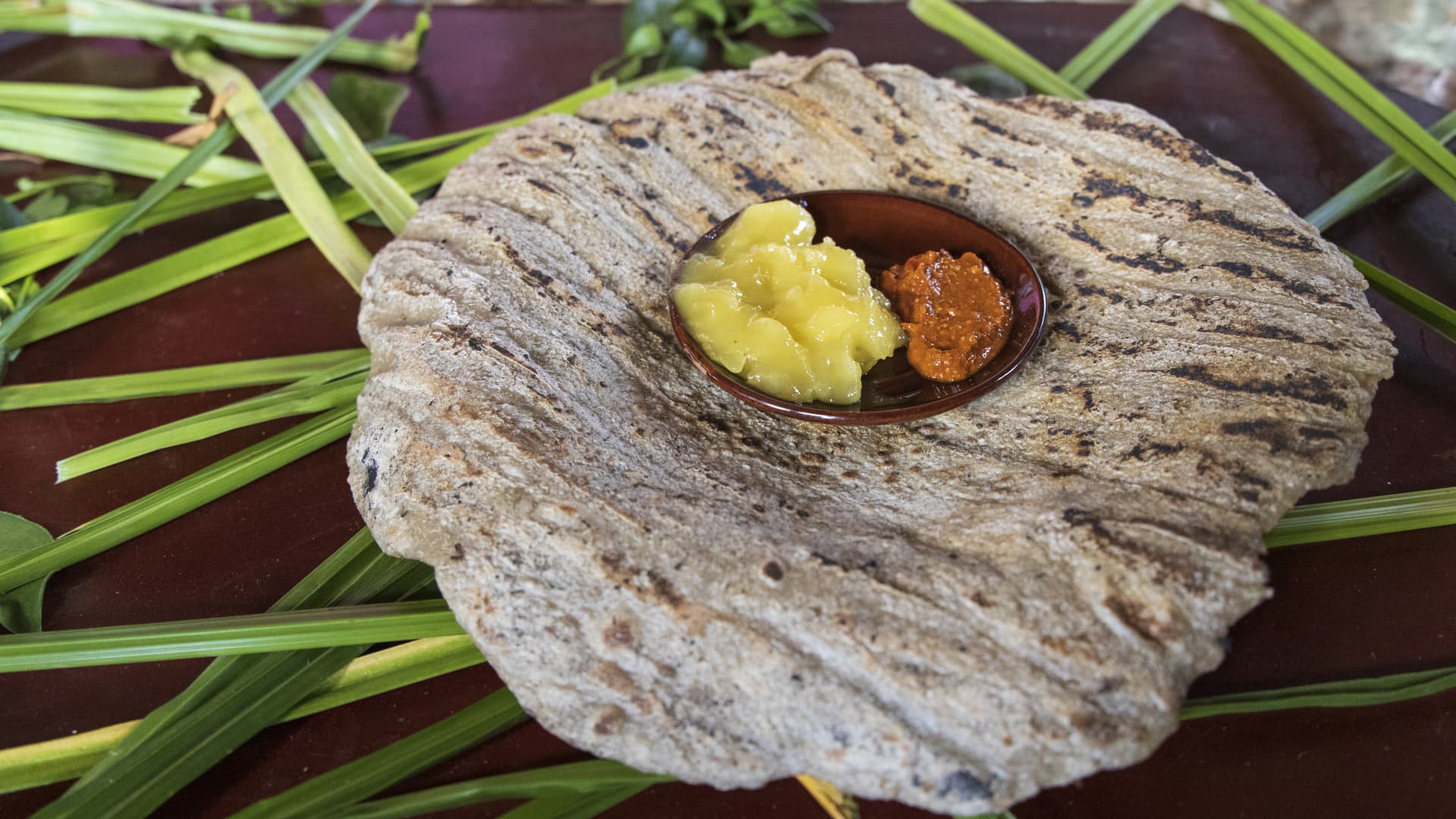Play all audios:
Kocho, a food produced using enset, served with honey and red pepper sauce. Mwayout | Istock | Getty Images Earlier this year, shoppers in the U.K. faced a shortage of fresh fruit and
vegetables, with some of the country's grocery stores rationing produce like tomatoes, lettuce and peppers. The reasons behind the scarcity of ingredients crucial to a tasty salad were
complicated and varied, ranging from high energy prices to adverse weather conditions in supplier countries. While the shortage has more or less abated, it did highlight the fragile nature
of our food system and the huge importance of food security. In 2022, a major report from the United Nations showed the scale of the problem. "Between 702 and 828 million people were
affected by hunger in 2021," The State of Food Security and Nutrition in the World report said. The U.N.'s report flagged the "major drivers of food insecurity and
malnutrition: conflict, climate extremes and economic shocks, combined with growing inequalities." MORE FROM CNBC CLIMATE: Meet the 33-year-old Canadian chemist and the renowned MIT
professor who are building the ‘electric vehicle of cement making’ Converting gas-powered cars to EVs is a booming business Ex-Tesla engineer builds Aigen robots to eliminate weeds without
pesticides With concerns about the effects of climate change on the agriculture sector mounting, what we grow and eat could be on the cusp of a significant shift. Crops unfamiliar to many of
us could have a crucial role to play in the years ahead. In June 2022, scientists at the Royal Botanic Gardens, Kew, listed several sources of food that could play a big role in future
diets. They include seaweed; cacti like the prickly pear; a type of wild coffee able to cope with far warmer temperatures than Arabica coffee; and enset, also known as the false banana.
"Enset is a relative of the banana," James Borrell, research leader in Trait Diversity and Function at RBG Kew, told CNBC. "But whereas a banana is from Southeast Asia and you
eat the fruit, enset is from Africa and has been domesticated — and is only cultivated — in Ethiopia," he added. "You actually eat the whole trunk, or pseudo stem, and the
underground corm." "Something like 15 plants could feed a person for a year, so it's … very large, and it's very productive." The enset plant in Ethiopia. Enset is
also known as "the tree against hunger." Glen_pearson | Istock | Getty Images When it comes to food security, the potential of enset — which is also referred to as "the tree
against hunger" — appears to be considerable. Borrell told CNBC that it possesses a combination of traits and characteristics "very unusual in crops." "Firstly, it's
perennial, and so it keeps growing each year if you don't harvest it," he said. A fruit tree may also be perennial, he noted, "but it only produces its fruit at a certain
time of year — so you either need to consume it then or you need to store it." With enset, however, "you eat the whole thing ... so the fact that it gets larger each year, you can
simply harvest it when you need it." A 'BANK ACCOUNT OF FOOD' That, Borrell said, makes it particularly useful for subsistence farmers working on several crops. "If some
year your other crops fail, or they don't have a sufficient yield, you can eat a little bit more of your enset," he said. "If you have a good year for your other crops, you
can eat a bit less of your enset." That means enset could "buffer seasonal food insecurity." "For a subsistence farmer, that's an amazing product," he added.
"It's like a bank account of food, it's like a green asset that you can maintain and nurture and if you don't use it, it keeps accumulating." At the moment, RGB Kew
says enset supplies food to 20 million people in Ethiopia, but the organization adds it "could be a climate-smart crop for the future" thanks to its "high yield and resilience
to long periods of drought." In late 2021, researchers based in the U.K. and Ethiopia, including Borrell, published a paper in Environmental Research which provided a tantalizing
glimpse of the role it might play in the future. "We find that despite a highly restricted current distribution, there is significant potential for climate-resilient enset expansion
both within Ethiopia and across eastern and southern Africa," the authors said. Kocho, produced using the enset plant, photographed in Ethiopia. Glen_pearson | Istock | Getty Images
Could, then, the cultivation of enset extend from Ethiopia to other parts of the world, buffering other crops in the process? "The very important caveat is that it is an Ethiopian
crop," Borrell said. "And so those kinds of decisions are entirely up to Ethiopia … it's Ethiopia's indigenous knowledge, and it's Ethiopia's farmers that have
spent thousands of years domesticating it." "So although we can talk about what is the potential and would it work, it's very specifically not up to us to say whether it
should happen and if it can happen." It's unlikely, then, that people outside of Ethiopia will be seeing enset on their plate anytime soon. Nevertheless, its resilience and
importance in shoring up supply for farmers there illustrate how practices rooted in tradition may have a big role to play in the way we think about and consume food. "It's an
amazing crop, with amazing indigenous knowledge underlying it," Borrell said. "I think the message is that this is just one of hundreds or even thousands of underutilized crops
that are not particularly extensively researched, and they're not widely known." "So for every plant we talk about, like enset, there's many others that could have …
particular combinations of traits that could help us address a challenge that we face."

